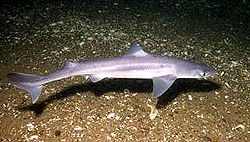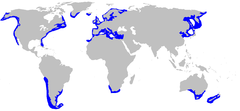- Spiny dogfish
-
Spiny Dogfish 
Conservation status Scientific classification Kingdom: Animalia Phylum: Chordata Class: Chondrichthyes Subclass: Elasmobranchii Order: Squaliformes Family: Squalidae Genus: Squalus Species: S. acanthias Binomial name Squalus acanthias
Linnaeus, 1758
Range of the spiny dogfish (in blue) The spiny dogfish, spurdog, mud shark, or piked dogfish, Squalus acanthias, is one of the best known of the dogfish which are members of the family Squalidae in the order Squaliformes. While these common names may apply to several species, Squalus acanthias is distinguished by having two spines (one anterior to each dorsal fin) and lacks an anal fin. It is found mostly in shallow waters and further offshore in most parts of the world, especially in temperate waters.
Contents
Morphology and behavior
The spiny dogfish has dorsal spines, no anal fin, and white spots along its back. The caudal fin has asymmetrical lobes, forming a heterocercal tail. The species name acanthias refers to the shark's two spines. These are used defensively. If captured, the shark can arch its back to pierce its captor. Glands at the base of the spines secrete a mild poison.
Males mature at around 11 years of age, growing to 80–100 cm (2.6–3.3 ft) in length; females mature in 18–21 years and are slightly larger than males, reaching 98.5–159 cm (3.23–5.2 ft).[1] Both sexes are greyish brown in color and are countershaded. Males are identified by a pair of pelvic fins modified as sperm-transfer organs, or "claspers". The male inserts one clasper into the female cloaca during copulation.
Reproduction is aplacental viviparous, which was before called ovoviviparity. Fertilization is internal. The male inserts one clasper into the female oviduct orifice and injects sperm along a groove on the clasper's dorsal section. Immediately following fertilization, the eggs are surrounded by thin shells called "candles" with one candle usually surrounding several eggs. Mating takes place in the winter months with gestation lasting 22–24 months. Litters range between 2 and 11 but average 6 or 7.
Commercial use
Spiny dogfish are fished for food in Europe, the United States, Canada, New Zealand and Chile. The meat is primarily consumed in England, France, the Benelux countries and Germany. The fins and tails are processed into fin needles and are used in less expensive versions of shark fin soup in Chinese cuisine. In England this and other dogfish are sold in fish and chip shops as "rock salmon" or "huss", in France it is sold as "small salmon" (saumonette) and in Belgium and Germany it is sold as "sea eel" (zeepaling and Seeaal, respectively). It is also used as fertilizer, liver oil, and pet food, and, because of its availability, cartilaginous skull, and manageable size, as a popular vertebrate dissection specimen, in both high schools and universities.
Conservation Status & Management
Once the most abundant shark species in the world, populations of Squalus acanthias have declined significantly. They are classified in the IUCN Red List of threatened species as Vulnerable globally and Critically Endangered in the Northeast Atlantic, meaning stocks around Europe have decreased by at least 95%. This is a direct result of overfishing to supply northern Europe's taste for Rock Salmon, Saumonette or Zeepaling. Despite these alarming figures, very few management or conservation measures are in place for Squalus acanthias. In EU waters, a Total Allowable Catch (TAC) has been in place since 1999, but until 2007 it only applied to ICES Areas IIa and IV. It was also set well above the actual weight of fish being caught until 2005, rendering it meaningless. Currently (2009), the TAC stands at 316t for ICES Areas IIa & IV, 104t for ICES Area IIIa and 1,002t for ICES Areas I, V - VIII, XII & XIV. In addition, a maximum landing size of 100 cm has been imposed in order to protect the most valuable mature females. The European Commission has stated that the TAC for 2010 will be set at 0t, ending targeted fishing for the species in EU waters. It remains to be seen if populations will be able to recover.[2]
In the recent past the European market for spiny dogfish has increased dramatically, which led to the overfishing and decline of the species. This drastic increase led to the creation and implementation of many fishery management policies placing restrictions on the fishing of spiny dogfish. However, since the species is a late maturing fish, it takes a while to rebuild the population.
In 2010, Greenpeace International has added the spiny dogfish to its seafood red list. "The Greenpeace International seafood red list is a list of fish that are commonly sold in supermarkets around the world, and which have a very high risk of being sourced from unsustainable fisheries."[3]
In recent years however, the US has implemented fishing controls and opened up the fishery. The current proposed quota for 2011 is 35.5m lbs. with a trip limit of 4000 lbs. This is a gain over past years in which the quota has ranged from 5-20m lbs. with trip limits from 2000- 3000 lbs.[4]. In 2010, NOAA announced the Eastern US Atlantic Spiny Dogfish stocks to be rebuilt [5] and in 2011 concerns about dogfish posing a serious predatory threat to other stocks resulted in an emergency amendment of the quota with nearly 15 million pounds being added [6] .
See also
References
- ^ Kindersley, Dorling (2001,2005). Animal. New York City: DK Publishing. ISBN 0-7894-7764-5.
- ^ Fordham, S; Fowler, S.L; Coelho, R; Goldman, K.J; Francis, M; 2006. Squalus acanthias. In: IUCN 2008. 2008 IUCN Red List of Threatened Species. www.iucnredlist.org
- ^ Greenpeace International Seafood Red list
- ^ "Mid- Atlantic Council on Dogfish". http://www.ahherald.com/newsbrief-mainmenu-2/monmouth-county-news/11896-mid-atlantic-council-adopts-increase-in-spiny-dogfish-quotas.
- ^ "NOAA Announces Spiny Dogfish Stocks to be Rebuilt". NOAA. http://www.nmfs.noaa.gov/fishwatch/species/atl_spiny_dogfish.htm.
- ^ "Spiny Dogfish Threaten Other Fish Stocks". http://www.prnewswire.com/news-releases/threat-of-dogfish-sharks-unite-commercial-and-recreational-fishermen-from-maine-to-north-carolina-61723757.html.
- Fordham et al. (2006). Squalus acanthias. 2006. IUCN Red List of Threatened Species. IUCN 2006. www.iucnredlist.org. Retrieved on 11 May 2006. Database entry includes a lengthy justification of why this species is vulnerable
- "Squalus acanthias". Integrated Taxonomic Information System. http://www.itis.gov/servlet/SingleRpt/SingleRpt?search_topic=TSN&search_value=160617. Retrieved 24 January 2006.
- Froese, Rainer, and Daniel Pauly, eds. (2005). "Squalus acanthias" in FishBase. 10 2005 version.
External links
- [http://video.msn.com/v/us/v.htm?g=2F3EEE6E-6ED5-444C-8A74-6A0899FA0B85&f=msnhome&fg=copy Spiny dogfish attacked by Giant Pacific Octopus
- Spiny dogfish at Animal Diversity Web
Categories:- IUCN Red List vulnerable species
- Fish of Europe
- Fish of Ukraine
- Fish of the Mediterranean Sea
- Fish of the Black Sea
- Squalidae
Wikimedia Foundation. 2010.


